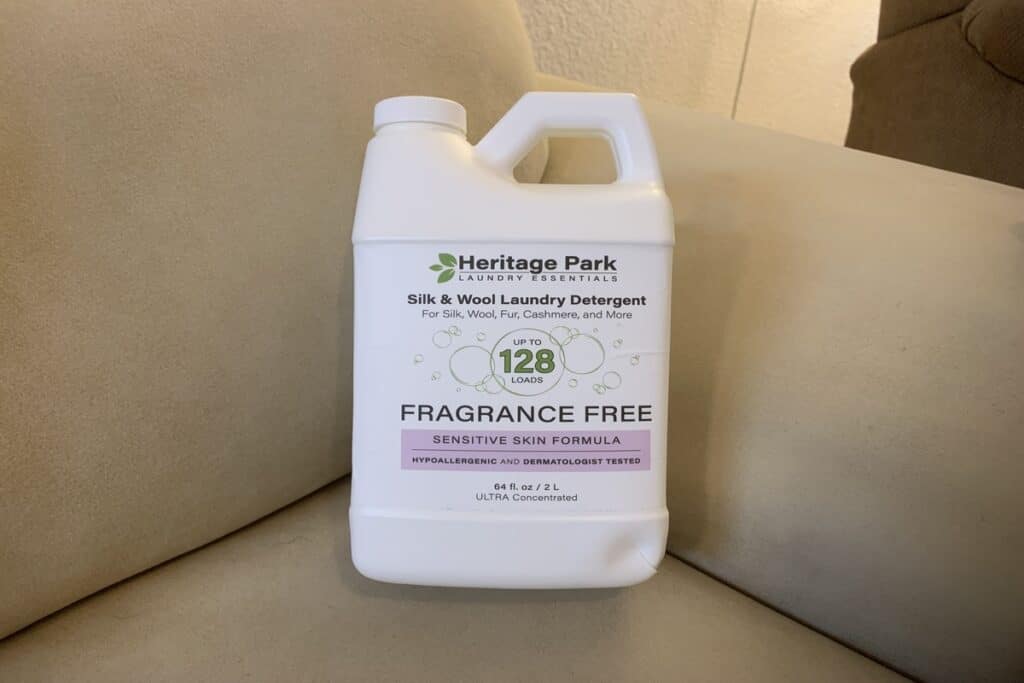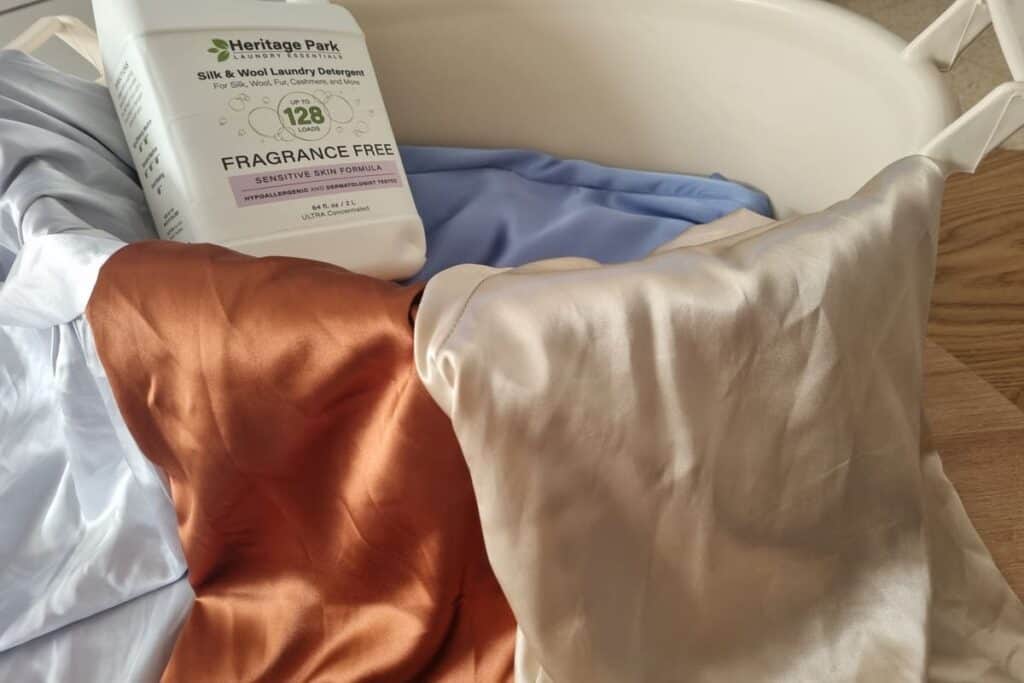Are You Supposed to Wash Silk? Expert Tips for Silk Care
I absolutely love wearing silk. The luxurious feel of the fabric against my skin is second to none. However, taking care of my silk clothes has always made me nervous.
Silk has a reputation for being extremely delicate and prone to damage if not handled properly.
Over the years, through trial and error, I’ve learned the ins and outs of washing silk without ruining it.
In this article, I’ll share everything I know, from decoding fabric care labels to mastering gentle washing techniques. Follow my tips and you’ll be washing your silk with confidence!

Understanding Silk Fabric
Before we get our hands wet, let’s go over some key facts about silk:
- Silk is a natural protein fiber, which comes from the cocoons of silkworms. This gives it a shimmery, luxurious appearance.
- However, silk is also very delicate. The fibers can easily snag or tear when handled roughly.
- Silk does not hold its shape well when wet. It tends to stretch and lose structure when soaked in water.
Many people mistakenly think you can never get silk wet. This simply isn’t true. With care, silk can be hand washed and retain its beauty. The key is to be extremely gentle.
Pre-Wash Considerations
Before washing any silk item, you need to take a few preparatory steps:
- Check the fabric care label. Many silk garments are dry clean only. If the label specifically says “Dry Clean,” send it to a professional.
- Inspect the garment for stains or discoloration. Set aside any stained items for stain pretreatment.
- Make sure the silk is colorfast. Do a test wash on a hidden hem or inner seam.
- Have a clean, flat space available for laying out the silk to dry. This is crucial to avoid creases.

Washing Silk Without Ruining It
If your silk care label allows for hand washing, follow my detailed instructions below. I’ll walk you through the entire process step-by-step.
What You’ll Need:
- Large sink or basin for washing.
- Soft towels. Silk should always be patted dry, never wrung out.
- Garment rack or clothesline for flat drying.
- Mild liquid detergent or delicate wash. Avoid powder detergents.
Heritage Park Laundry Detergent (link to Amazon) is my go-to for silk items. It’s incredibly gentle on the delicate fabric, ensuring that my silks last longer and stay gorgeous.

- Fill your sink or basin with cool or lukewarm water. The temperature should not exceed 30°C (86°F).
- Add a small amount of mild detergent, around 1-2 tsp. Swish the water gently to dissolve and disperse the detergent.
- Submerge your silk item fully underwater. I recommend washing only one piece at a time.
- Let the garment soak for 3-5 minutes so the detergent can get to work.
- Agitate the silk very lightly with your hands, almost like a gentle massage. Avoid vigorous scrubbing or twisting motions.
- Drain the dirty wash water and refill your basin with clean water.
- Rinse the silk thoroughly under the fresh water to eliminate all traces of detergent. Change the water and rinse again if needed.
- Drain the rinse water. Lift out the garment, holding it in both hands to support the wet silk.
- Lay the silk piece on a non-terry, very soft towel. Roll up the towel and silk together and press to absorb moisture.
- Remove the silk from the towel and lay flat on a drying rack or clothesline. Smooth out all wrinkles and creases.
- Allow silk to air dry completely before wearing or storing. Do not place in the dryer!








And that’s it! As you can see, washing silk is not overly complicated if you take it slow and handle it gently.
The most important things are lukewarm water, mild detergent, and delicate agitation.
The Debate: Hand Wash vs. Machine Wash
Can you put silk in the washing machine? In some cases, yes. But there are definite risks.
The main benefits of machine washing are convenience and time savings. However, the agitation and spin cycles used by most washers can damage silk fibers.
Delicate cycles try to minimize this, but it’s still easy for silk to snag.
I only recommend machine washing for very sturdy silks labeled “washable silk” or “machine washable silk.”
For any high-quality or delicate silk, I suggest hand washing. It takes more effort but is far safer for the fabric.
Below I’ve summarized the pros and cons of each method:
Hand Washing Silk
Pros:
Cons:
Machine Washing Silk
Pros:
Cons:
When in doubt, opt for hand washing. It’s the best way to keep your silks looking fabulous wash after wash.
Frequency of Washing Silk
How often you need to wash silk depends on the garment style and how frequently it’s worn. Here are my general recommendations:
| Silk Item | Recommended Washing Frequency |
| Silk blouses | After 3-4 wears, or when noticeably soiled. Frequent washing preserves freshness |
| Silk shirts and dresses | After 3-5 wears, or when noticeably soiled. Spot clean as needed between full washes |
| Silk pants and skirts | After 5-7 wears, or when visibly soiled |
| Silk scarves and ties | Only if visibly dirty. These accessories don’t have direct skin contact, so they tend to stay cleaner longer between washes |
| Silk lingerie and intimates | After every wear or every second wear |
| Silk bedding | Every 1-2 weeks, depending on use and personal hygiene habits |
When in doubt, let your nose be the guide. If a silk garment has started to smell, it’s definitely time for laundering.
Understand fabric maintenance in my post on how often you should wash silk.

Special Considerations for Different Silk Items
Washing requirements can vary depending on the type of silk garment. Here are my top care tips:
Silk Blouses and Shirts
- Unbutton collars, cuffs, and plackets so the detergent can penetrate folded areas. This prevents ring-around-the-collar.
- Untuck shirts from pants or skirts – leave hems hanging loose.
- Don’t wash silk blouses with heavy denim or fabrics that could snag.
Silk Pants and Skirts
- For lined silk, treat the outer shell and lining separately.
- Turn pants inside-out before washing to protect embroidery or detailing on the outside.
- Hang silk pants by the cuffs or hem rather than clipping waistbands to a drying rack.
Silk Lingerie
- Never wash silk bras with hardware or underwires – delicate fabrics can snag.
- Use lingerie wash bags to protect straps, lace, and trim.
- Lay flat to dry or hang delicates from the bottom rather than the straps or bands to maintain shape.
Silk Scarves
- Pretreat any makeup stains along the edges before washing in cool, mildly soapy water.
- Roll in a towel to remove moisture rather than wringing or twisting. Let scarves air dry flat.
Silk Bedding
- Wash silk pillowcases frequently to eliminate facial oils, hair products, and makeup. Use a gentle shampoo to tackle any staining around the pillow edges.
- For duvet covers, insert a spare sheet inside before washing to avoid shrinkage.

Post-Wash Care
How you care for silk after washing is just as important as the wash itself. Follow these steps once your silk is clean:
- Lay pieces flat on thick, soft towels and roll up to remove excess moisture. Avoid wringing or twisting.
- Smooth out silk on a flat surface before air drying. Reshape garments by gently tugging into place.
- For wrinkle-prone areas like shirt collars, use steam from your iron or garment steamer to relax the fibers. Avoid direct iron-to-silk contact.
- Once fully dry, store silk in breathable garment bags rather than airtight plastic. This prevents mildew and yellowing over time.
- Steam or gently iron silk garments before rewearing to freshen them up. Use medium heat and place a cloth between the iron and silk.
With proper post-wash steps, your silk will maintain its sheen, drape, and vibrancy for many wears to come.
When to Choose Dry Cleaning
While many silk garments can be hand washed at home, dry cleaning is sometimes the safer choice. Here are cases when I would send silk out for professional cleaning:
- You’re unsure of the fabric content or construction. Unknown silks are better left to expert handling.
- The garment has fancy beading, sequins, trim, or other embellishments that could snag during hand washing.
- You’ve tried hand washing without success in removing grease stains, underarm discoloration, or severe perspiration marks. The chemical solvents used in dry cleaning can tackle these more effectively.
- The silk has visibly weakened or frayed over time. A professional laundry service is less likely to damage fragile fabrics.
- The care instructions specifically say “Dry Clean Only.” This may indicate a more delicate silk fabric unsuitable for water.
I’ve explored the effects of prolonged water exposure on silk in this article.
While pricier than home washing, dry cleaning is worthwhile for keeping treasured silk pieces in flawless condition.
For best results, find a specialty cleaner experienced in handling fine silks.

Common Mistakes to Avoid
It’s easy to ruin silk if you make the wrong moves during laundering. Here are some common errors along with prevention tips:
| Mistake | Prevention |
| Using hot water | Always wash silk in lukewarm water. High heat damages silk fibers |
| Overloading the wash basin | Wash only 1 or 2 silk items together so they can move freely |
| Vigorous scrubbing | Use extremely light, gentle motions when agitating silk in water |
| Wringing or twisting wet silk | Roll silk in a towel to absorb moisture. Never wring or twist it |
| Letting silk air dry while hanging | Silk should always be dried flat to prevent stretching |
| Storing silk in plastic bags | Use breathable garment bags for storage to avoid mildew |
| Mixing delicates with heavy fabrics | Wash silk separately to prevent snags from zippers, denim, buttons, etc |
Keep these common blunders in mind as you care for your silk. Avoiding them will ensure your clothes keep their vibrancy and texture for many years.
Conclusions
I hope these comprehensive tips have shown washing silk is not as intimidating as it seems.
With proper techniques, you can keep your silk garments looking revitalized and luxurious at home.
The keys are using mild detergent, handling silk gently, laying flat to dry, and taking precautions based on fabric type.
Follow my advice and wave goodbye to those pesky dry cleaning bills!
By mastering these cleaning fundamentals, you’ll maintain their exquisite feel and beauty for many seasons to come.
